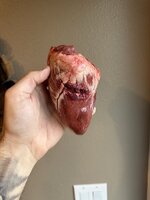To OP:
For the cow (and possibly the bull) I think you need to get better at tracking. Of course it's hard to say without being there, but you can follow a track a long way between drops of blood. Sometimes blood is the tiniest speck, sometimes you have to turn leaves upside down because it's on the bottom side. Sometimes there just isn't any blood for a while, but you can try to think like the wounded animal and, based off of where it was, estimate where it "should" be headed. Rather than grid searching, keep looking for tracks/blood in all the possible directions or trails (starting with most likely). You might be surprised how far you can take it, and how often you actually find the animal.
Looks like it's already been covered, but I think you aimed way too high on the bull.
On the other subject of shooting something after dark: I've never done it, and I'm the type that reads every bit of the regulations and follows them exactly. But I lost of a buck because of it. I hit him high (archery). No blood trail, spotted him after half hour or so walking normally and saw red circle on exit side. Looked like high lung, below the spine, and thought he should be dead. Just before dark I found him still up, and shot him again from maybe 10-20 yards, but through a pretty thick bush. Couldn't see the hit, but it produced some blood which I followed. Hours later, searching around with flashlight down near town where hunting is illegal, and people are probably watching me, I spot him, right across the fence on neighbors property. Standing there broadside. I walked away, and came back in the morning. Don't see him. Got permission from neighbor, went looking in there, bumped him and watched him run away across a construction site into other neighbor's property. Could see second shot clearly center punched his guts (deflected off the bush). He should be dead 2x by now. Few more hours go by, permission from 2 more neighbors, and I bumped him back to our property, no blood other than on the fence. Kept searching but no luck. Found his head the next year. Kind of wished I'd just put an arrow in him with the headlamp.

